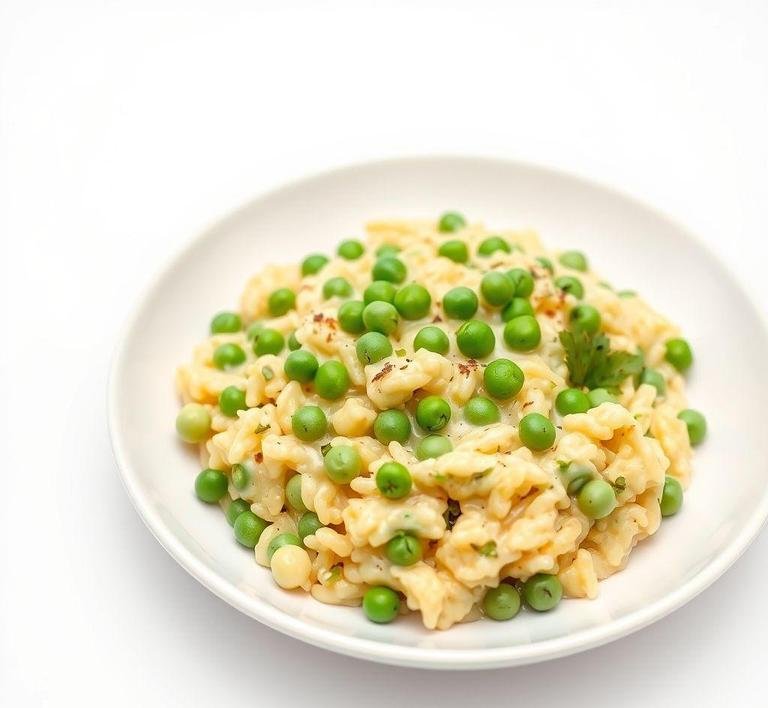Imagine a bowl of risotto so lush and vibrant, it practically bursts with springtime in every bite. That’s Nigella Lawson’s Pea Risotto for you. It’s not just any risotto – it’s a celebration of sweet, fresh peas mingling with the creamy, slow-cooked Arborio rice, enriched by parmesan and a whisper of butter. Nigella has this effortless way of taking simple ingredients and transforming them into something almost poetic and this risotto is no exception.
The first time I tried making this dish was on a quiet Sunday afternoon, craving something soothing but bright. The green color alone felt like a little boost of happiness. What struck me most was how the peas weren’t just tossed in for garnish. they were blended into the risotto, giving it a silky, verdant richness. It felt like eating spring itself. Nigella’s version is both elegant and homey, perfect for impressing guests or indulging yourself on a mellow night in.
Nigella Pea Risotto Recipe
Ingredients Needed

Here’s the lineup for this green dream:
- Arborio rice: The star of the risotto world. Its starchy creaminess is what gives risotto that signature texture.
- Frozen peas: Fresh peas are divine but frozen work just as well and keep their sweetness.
- Vegetable or chicken stock: Warming and flavorful, it’s the liquid that slowly coaxes the rice into creaminess.
- Onion: Finely chopped, it creates the aromatic base.
- Garlic: Just a clove or two, for that subtle, comforting depth.
- Parmesan cheese: The final touch, bringing salty, nutty richness.
- Butter: To finish, melting into the risotto and making it silkier.
- Olive oil: For sautéing the onion and garlic.
- White wine (optional): Adds a slight acidity that balances the creaminess. I always add it if I have a good bottle open.
When I first gathered these ingredients, I realized how little fuss this dish actually requires which made it feel even more accessible. It’s one of those recipes that lets the ingredients really shine without needing anything fancy or exotic.
Equipment Needed
Luckily, making this risotto doesn’t require a pantry full of gadgets. Here’s what you’ll want on hand:
- A large, heavy-bottomed pan or skillet: This helps with even cooking and prevents the rice from sticking or burning.
- A wooden spoon: Essential for that patient, gentle stirring that risotto demands.
- A ladle: For adding the stock gradually. this is the heart of the risotto technique.
- A blender or food processor: For pureeing the peas into that lush, green sauce.
- A grater: To freshly grate your parmesan (it really does make a difference).
- Measuring cups/spoons: To keep everything balanced.
When I first made this, I underestimated the stirring part. trust me, it’s a workout but so worth it. A good wooden spoon becomes your best friend in the kitchen during this process.
Instructions To Make Nigella Lawson’s Pea Risotto
Here’s the step-by-step, with a little sprinkle of my own kitchen wisdom:
- Prep your ingredients: Finely chop the onion and garlic, grate the parmesan and if using frozen peas, let them thaw slightly.
- Start the base: Heat olive oil in your pan, then gently sauté the onion until translucent. Add the garlic and cook for just a minute more. you want to smell it, not burn it.
- Toast the rice: Add the Arborio rice to the pan, stirring well so every grain gets coated in oil and warms up. This step is crucial; it helps the rice absorb liquids evenly.
- Add wine (optional): Pour in a splash of white wine and let it bubble away until almost evaporated. This adds a bright note that cuts through the richness.
- Begin the slow cook: Ladle in your warm stock one scoop at a time, stirring constantly and waiting for the liquid to almost disappear before adding more. This slow absorption releases the starch and creates that creamy texture risotto is famous for.
- Pea puree: While the risotto cooks (it takes around 18-20 minutes), blitz your peas with a bit of stock or water until smooth.
- Combine: When the rice is just tender, stir in the pea puree. The risotto will turn this gorgeous bright green and become silky and luscious.
- Finish with butter and parmesan: Turn off the heat and stir in a knob of butter and a generous handful of parmesan. This is where the dish gets that dreamy finish.
- Taste and season: Always taste at the end. add salt, pepper or a squeeze of lemon juice if you want a little zing.
I remember the first time I made this, I was worried the risotto wouldn’t be creamy enough. But the slow ladling and stirring is key. patience really pays off here. The green color stunned me and that final bite was like a little celebration in my mouth.
What I Learnt
Making Nigella’s Pea Risotto taught me more than just how to cook a dish. it taught me the art of patience in the kitchen. Risotto is a slow dance and rushing it just won’t do. I also learned how a few simple, fresh ingredients can make magic when treated with care.
One unexpected lesson was how versatile this risotto is. it’s a perfect blank canvas. Adding fresh herbs like mint or basil or a squeeze of lemon, completely changes the mood of the dish. It’s comforting but never boring.
Nigella’s approach showed me that food doesn’t have to be complicated to feel special. Her effortless style encourages you to lean into the process and enjoy each step which I think is a beautiful way to cook and live.
FAQs
Can I Make Nigella Lawson’s Pea Risotto Ahead Of Time?
While risotto is best enjoyed fresh, you can prepare the base in advance. Just cook the rice until it’s al dente, then store it in the fridge. When you’re ready to serve, warm it up and stir in the peas and a bit of extra broth to finish it off.
What Type Of Rice Is Best For Nigella’s Pea Risotto?
Nigella uses Arborio rice in her recipe, which is perfect for creating that creamy texture. It’s high in starch and absorbs the broth beautifully, making the risotto rich and satisfying.
Can I Use Frozen Peas Instead Of Fresh For This Recipe?
Absolutely! Frozen peas actually work really well in this dish. They’re sweet, vibrant, and you won’t notice the difference once they’re stirred through the creamy risotto.


